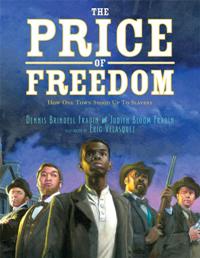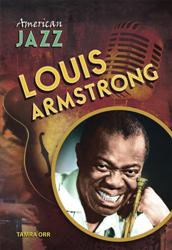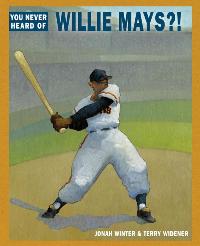2018 School Spending Survey Report
On the Radar: Top Picks from the Editors at Junior Library Guild: K-8 Books on African Americans Who Inspire
Since 1976, every U.S. president has designated February as Black History Month. From slavery to civil rights, and science to music, the following books for young readers honor the accomplishments of African Americans.
 CLINE-RANSOME, Lesa. Light in the Darkness: A Story About How Slaves Learned in Secret. illus. by James E. Ransome. Disney/Jump at the Sun. 2013. ISBN 9781423134954. JLG Level: I+ : Independent Readers (Grades 2–4). In an age when some kids drop out of school because they’re bored, it seems ironic that just over 100 years ago people of all ages risked their lives to learn to read. Rosa goes with her mother in the dark of night to learn her letters in a pit school. Pit schools were large holes covered in branches where slaves could hide while learning the alphabet. They could be whipped for every letter learned. Based on historical facts, the Ransomes weave an enlightening story about the thirst for knowledge.
CLINE-RANSOME, Lesa. Light in the Darkness: A Story About How Slaves Learned in Secret. illus. by James E. Ransome. Disney/Jump at the Sun. 2013. ISBN 9781423134954. JLG Level: I+ : Independent Readers (Grades 2–4). In an age when some kids drop out of school because they’re bored, it seems ironic that just over 100 years ago people of all ages risked their lives to learn to read. Rosa goes with her mother in the dark of night to learn her letters in a pit school. Pit schools were large holes covered in branches where slaves could hide while learning the alphabet. They could be whipped for every letter learned. Based on historical facts, the Ransomes weave an enlightening story about the thirst for knowledge.  DAVIDSON, Tish. African-American Scientists and Inventors. Mason Crest. 2013. ISBN 9781422223758. JLG Level: H35 : Series Nonfiction: History 3–5 (Grades 3–5). Thomas Jennings received the first patent given to an African American for his dry cleaning process in 1821. When car traffic became a problem in the early 1920s, Garrett Morgan invented a crossing pole to regulate the vehicles. Mae Jemison was the first African American female astronaut to fly in space in 1992. In five short chapters, Davidson introduces African American scientists and inventors who made a difference in agriculture, industry, transportation, medicine, and aerospace. When George W. Carter’s crop rotation plan resulted in an excess harvest of peanuts, he invented 270 uses for them. Edison’s light bulb was short-lasting and expensive. Lewis Latimer succeeded in making a less expensive, longer-lasting carbon filament. In spite of racism, lack of education, and resources, these African Americans made important contributions to our history. Chapter notes, chronology, glossary, and resources support this informational text.
DAVIDSON, Tish. African-American Scientists and Inventors. Mason Crest. 2013. ISBN 9781422223758. JLG Level: H35 : Series Nonfiction: History 3–5 (Grades 3–5). Thomas Jennings received the first patent given to an African American for his dry cleaning process in 1821. When car traffic became a problem in the early 1920s, Garrett Morgan invented a crossing pole to regulate the vehicles. Mae Jemison was the first African American female astronaut to fly in space in 1992. In five short chapters, Davidson introduces African American scientists and inventors who made a difference in agriculture, industry, transportation, medicine, and aerospace. When George W. Carter’s crop rotation plan resulted in an excess harvest of peanuts, he invented 270 uses for them. Edison’s light bulb was short-lasting and expensive. Lewis Latimer succeeded in making a less expensive, longer-lasting carbon filament. In spite of racism, lack of education, and resources, these African Americans made important contributions to our history. Chapter notes, chronology, glossary, and resources support this informational text.  FRADIN, Judith Bloom and Dennis Brindell Fradin. The Price of Freedom: How One Town Stood Up to Slavery. illus. by Eric Velasquez. Walker. 2013. ISBN 9780802721679. JLG Level: NE : Nonfiction Elementary (Grades 2–6). Husband and wife team up in an edge-of-your-seat picture book about a town that stands together to save one of their own. In spite of Ohio’s free state status, the Fugitive Slave Act allows slave hunters to capture runaways and return them to slavery for the reward money. Runaway and teacher John Price is in Oberlin, Ohio when Anderson Jennings and his team catch up with him. Thirteen-year-old Shake Boynton accepts $20 to help capture the fugitive. As the slave hunters take Price to nearby Wellington, they pass college student, Ansel Lyman, who runs to town for help. Hundreds of community members join in the fight to rescue Price. The narrative gets stronger when the Oberlin residents are arrested; a lone girl stands up for her teacher, “There is more goodness in his little finger than in your whole carcass!” The price of freedom in this town is three months in jail, but their release binds them together in a pledge, “No fugitive slave shall ever be taken from Oberlin either with or without a warrant, if we have power to prevent it.” Powerful illustrations accompany this amazing tale.
FRADIN, Judith Bloom and Dennis Brindell Fradin. The Price of Freedom: How One Town Stood Up to Slavery. illus. by Eric Velasquez. Walker. 2013. ISBN 9780802721679. JLG Level: NE : Nonfiction Elementary (Grades 2–6). Husband and wife team up in an edge-of-your-seat picture book about a town that stands together to save one of their own. In spite of Ohio’s free state status, the Fugitive Slave Act allows slave hunters to capture runaways and return them to slavery for the reward money. Runaway and teacher John Price is in Oberlin, Ohio when Anderson Jennings and his team catch up with him. Thirteen-year-old Shake Boynton accepts $20 to help capture the fugitive. As the slave hunters take Price to nearby Wellington, they pass college student, Ansel Lyman, who runs to town for help. Hundreds of community members join in the fight to rescue Price. The narrative gets stronger when the Oberlin residents are arrested; a lone girl stands up for her teacher, “There is more goodness in his little finger than in your whole carcass!” The price of freedom in this town is three months in jail, but their release binds them together in a pledge, “No fugitive slave shall ever be taken from Oberlin either with or without a warrant, if we have power to prevent it.” Powerful illustrations accompany this amazing tale.  ORR, Tamra. Louis Armstrong. Mitchell Lane. 2013. ISBN 9781612282640. JLG Level: S68 : Series Nonfiction: Social Studies 6–8 (Grades 6–8). Footnotes and short chapters combine for a brief introduction to a legend in America’s music history. From a night in jail to posthumous honors, jazz performer Louis Armstrong is portrayed as a man who blazed his own trail, never losing sight of his path. “Pleasing the people” was his way of life. He lived to make music, whether it was on the beat-up cornet he found for five dollars, or his last concert at the Waldorf Hotel. Orr blends research with dialogue to make Armstrong’s story more accessible to readers of. “My belief and satisfaction is that, as long as a person breathes, they still have a chance to exercise the talents they were born with.” While the author doesn’t omit the hardships Louis faced (multiple marriages, poverty, lack of education and musical training), she paints a vivid picture of a man who was born to bring music to everyone around him. Chapter notes, selected works, and other back matter supplement the short chapters.
ORR, Tamra. Louis Armstrong. Mitchell Lane. 2013. ISBN 9781612282640. JLG Level: S68 : Series Nonfiction: Social Studies 6–8 (Grades 6–8). Footnotes and short chapters combine for a brief introduction to a legend in America’s music history. From a night in jail to posthumous honors, jazz performer Louis Armstrong is portrayed as a man who blazed his own trail, never losing sight of his path. “Pleasing the people” was his way of life. He lived to make music, whether it was on the beat-up cornet he found for five dollars, or his last concert at the Waldorf Hotel. Orr blends research with dialogue to make Armstrong’s story more accessible to readers of. “My belief and satisfaction is that, as long as a person breathes, they still have a chance to exercise the talents they were born with.” While the author doesn’t omit the hardships Louis faced (multiple marriages, poverty, lack of education and musical training), she paints a vivid picture of a man who was born to bring music to everyone around him. Chapter notes, selected works, and other back matter supplement the short chapters.  WINTER, Jonah. You Never Heard of Willie Mays?! illus. by Terry Widener. Random/Schwartz & Wade. 2013. ISBN 9780375968440. JLG Level: SE : Sports Elementary (Grades 2-6). The award-winning baseball-loving team, Winter and Widener, is back with another grand slam. Willie Mays, the “Say-Hey Kid,” wanted to be the next Joe DiMaggio. Trouble was he lived in a time when major league baseball teams didn’t allow black men to play with white guys. Then in 1951, Mays got his chance. In his first bat at the Polo Grounds he hit a homerun. In 1954, the Hall of Fame-bound sportsman made a play that even today we still call “the Catch.” Fact-filled side bars add even more details about Willie and the records he broke. Beautiful acrylic illustrations allow readers to feel the tension in the game and the determination of a man who made a difference in the baseball’s history. For ideas about how to use these books and links to supportive sites, check out the Junior Library Guild blog, Shelf Life. Junior Library Guild is a collection development service that helps school and public libraries acquire the best new children's and young adult books. Season after season, year after year, Junior Library Guild book selections go on to win awards, collect starred or favorable reviews, and earn industry honors. Visit us at www.JuniorLibraryGuild.com.
WINTER, Jonah. You Never Heard of Willie Mays?! illus. by Terry Widener. Random/Schwartz & Wade. 2013. ISBN 9780375968440. JLG Level: SE : Sports Elementary (Grades 2-6). The award-winning baseball-loving team, Winter and Widener, is back with another grand slam. Willie Mays, the “Say-Hey Kid,” wanted to be the next Joe DiMaggio. Trouble was he lived in a time when major league baseball teams didn’t allow black men to play with white guys. Then in 1951, Mays got his chance. In his first bat at the Polo Grounds he hit a homerun. In 1954, the Hall of Fame-bound sportsman made a play that even today we still call “the Catch.” Fact-filled side bars add even more details about Willie and the records he broke. Beautiful acrylic illustrations allow readers to feel the tension in the game and the determination of a man who made a difference in the baseball’s history. For ideas about how to use these books and links to supportive sites, check out the Junior Library Guild blog, Shelf Life. Junior Library Guild is a collection development service that helps school and public libraries acquire the best new children's and young adult books. Season after season, year after year, Junior Library Guild book selections go on to win awards, collect starred or favorable reviews, and earn industry honors. Visit us at www.JuniorLibraryGuild.com. RELATED
RECOMMENDED
CAREERS
The job outlook in 2030: Librarians will be in demand
CAREERS
The job outlook in 2030: Librarians will be in demand
ALREADY A SUBSCRIBER? LOG IN
We are currently offering this content for free. Sign up now to activate your personal profile, where you can save articles for future viewing






Add Comment :-
Be the first reader to comment.
Comment Policy:
Comment should not be empty !!!